What a difference a month or so makes to fishing and life in general. With restrictions easing and a spell of cheerful weather, there has been a sense of sheer relief and optimism. Whether it’s watching trout on a stream or getting back to match fishing, freedom never felt so precious or welcome as it does now.
On a personal note, this is also the start of my favourite time of the year, as my guided days and various fishing lessons in the South West really get cooking again. Visitor numbers pick up, and while that leaves me less time to write, I just love being outdoors and showing others the best of the fishing on my home patch in Devon and Somerset. So where do I start?
Brilliant mixed coarse fishing on the Tiverton Canal
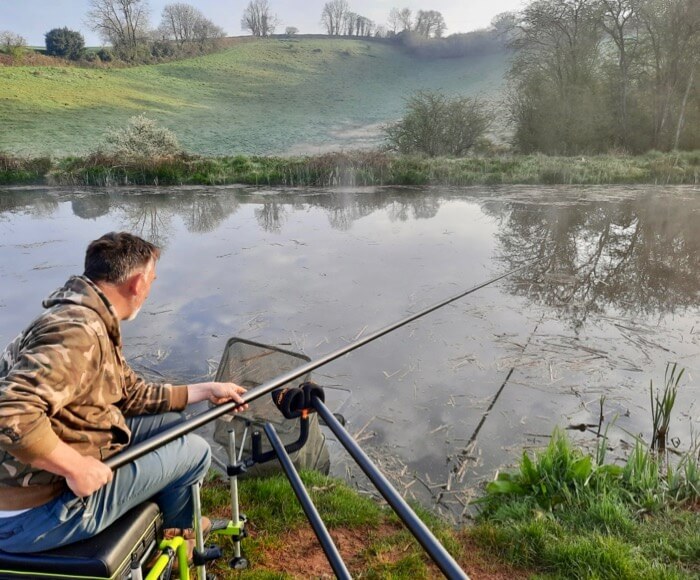
It’s no secret that the Grand Western or “Tiverton” Canal is a fantastic place to fish, especially when it comes to spring tench. The Exeter Canal might have the bigger fish, admittedly, but is rarely as consistent or as peaceful and scenic. In fact, the wildlife and lack of boats and human traffic make the “Tivvy” one of my favourite natural coarse fishing venues of all. And so it was with a keen sense of anticipation that I hosted Paul Blake for a mixed session of pole and fly fishing.
An unusual combination perhaps? Well, frankly who cares! Anyone who books with me can fish for whatever they like- I’ve never cared for being pigeonholed and I don’t lazily categorise my guests either. Quite often they’ll catch trout alongside coarse fish in the same few hours. And having enjoyed a fantastic guided day last summer, in which he had some awesome perch and chub on the River Tone, I already knew Paul was an angler who liked variety.
Originally, we’d planned to meet earlier in the year- but it was so unseasonably cold in early April that we were wise to hang on a bit. The same early crack of dawn start time remained though- as tench can’t be relied on to feed under bright, sunny skies. In particular, Paul wanted to do two things: sort out his pole fishing skills and catch a wild trout on the fly.
A fantastic pole fishing session
Another good reason Paul wanted to up his pole fishing game was that he’d just started match fishing with my clubmates at Tiverton DAS. And with one of the next league fixtures on the canal, right here at Greenway, it would make perfect sense to have some practice.
One thing I insist on when fishing any canal swim is thoroughly plumbing up and prepping at least two lines. Even pleasure fishing, it makes sense to have a small fish line close in, besides a longer line for tench or bream.
The best place for the bigger fish is so often not right across tight to the far bank (you’d need a very long pole in some swims!) but the bottom of the far shelf. In the swim we’d chosen, this was at full pole length, 13m. With an extension, or swinging the rig further, it started to shallow up quite quickly, but I felt the tench would be happiest feeding towards the bottom of the slope. A good plumb around will also reveal any snags or irregularities.
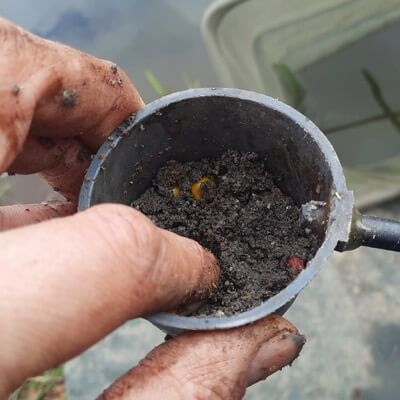
It’s then tempting to simply whack a load of bait in and fish- but this is not the best approach. Instead, the best course of action tends to be to introduce some bait and give the fish a minimum of 30 minutes or even an hour to settle. So, in went two pole cups, each with a few chopped worms and maggots, plus a few micropellets- as you can see above, a good tip here is to gently push a bit of moist groundbait on top of your feed to stop it bouncing out as you ship it in place.
Silver fish first!
Why does it pay to wait with the better fish? Well, for one thing, they properly get their heads down in this way. Yes, you might catch an early fish by going straight in, but it’s likely to spook any others nearby. Whereas with more time, I think a few things happen in the angler’s favour. The fish will get stuck in and cloud up the bottom, for one thing, making them less spooky. They will also attract more shoal mates- and the lack of any line or shot means they’ll have nothing to fear… at least until you drop in later!
In a five or six-hour match, of course, you also need more options than just one plan. You might draw a swim with no tench or bonus fish present, or perhaps it will fish hard. Either way, I always have a “keep out of mischief” line to try and put something in the net while the better fish settle.
For Paul, we picked a spot around 6m out (top section + two) and introduced some liquidised bread. Bread is so critical for Tiverton matches that a look at this was also a must for him. A slow falling rig was used with 0.10mm line and a fairly cute size 18 hook- and almost instantly we got bites!

Actually, we could have had a nice session just fishing this line, because roach and rudd quickly showed up. In a match or pleasure setting, these early fish are important- if nothing else they give the angler that all important confidence to fish positively. Not all were tiny either- one or two already needed the net.
Time for tench…
After about 40 minutes, it was then time to try the main line at 13m. No nonsense gear this time, I’d tied a rig of 0.14mm (4.4lbs) direct to a wide gape size 14 hook (a Drennan Wide Gape Match to be specific), which is spot on for small to medium worm baits or cocktails. Or indeed three or four dead maggots, which is another good shout.

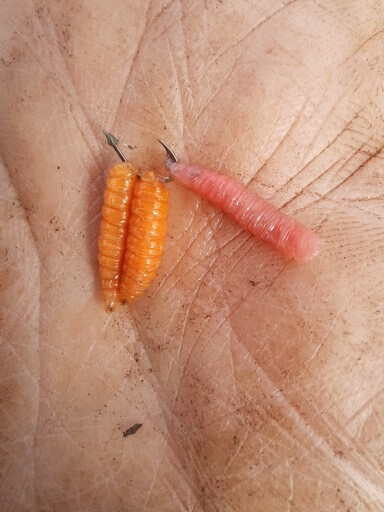
One of Paul’s questions was why not use sweet corn? Well, it’s not a bad bait, but the short answer is that I think the worm will get quicker and more positive bites. Another great thing about worm is that because it’s a lively offering, the fish can’t faff about too much and give half-hearted takes. Unlike an inert bait, it lashes around when disturbed and I believe that they have to engulf it properly and commit which is why the bites tend to be very decisive!
You do need to hook it properly though- and I like a dendrobaena with the head nipped off. This is then hooked through the bloody end and then followed by either a second worm section or tipped with a maggot or caster. Tipping with a smaller bait definitely helps to keep the hook point showing- and I sometimes like a yellow or orange maggot for this, to give a bright, contrasting colour.
Of course, sometimes maggots or smaller worms will draw nuisance tiny perch and other critters, which is why I’ll also take some lobworms and bigger baits. Actually, if you forget your lobs or corn, another good shout is sometimes to try a bunch of maggots on the hook- and as many as five or six isn’t too much of a mouthful for tench.
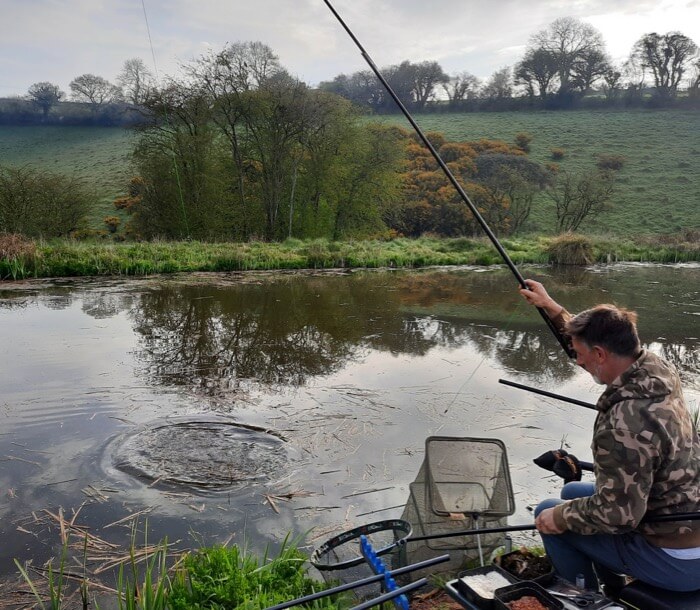
Enough of the theory, though, suffice to say the fish had indeed settled and within five minutes of trying the tench line, the float buried and we were away! At first I wondered if it wasn’t a skimmer- because Paul was a bit gentle and it didn’t really wake up for a few seconds. Actually, though, this is a good way to play the tench, especially when the far bank gets very weedy. If you go steady at first, the fish won’t do anything too drastic until they’re in the clearer, middle channel, whereas if you yank too hard from the get go, they can go ballistic and shoot for the far bank snags.
It was a cracking fish of about 3lbs. Tempting as it was to go straight in for another, though, I suggested chopping a few worms and adding these along with a bit of groundbait and maggot in a pole cup, just to settle the swim again.
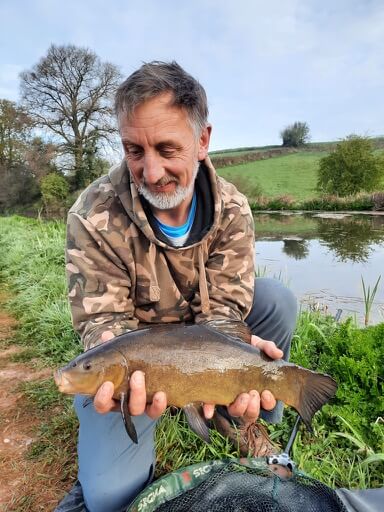
The plot thickens!
Once again, the inside line was still productive as we gave the tench a few minutes to settle again. I’d kept reminding Paul to add a small nugget of bread every few minutes, even when fishing the long line. A few maggots also went in- which can often help snare a bonus perch or two. Indeed, that’s exactly what happened on this occasion- with half a dozen or so fish from “pairs of eyes” up to 6oz or so. Again, not huge fish, but equally welcome for a match or pleasure session!
Another good lesson for Paul here was how to lay the rig in for different species. Indeed, this is one thing rarely touched on in most articles, but I tend to do this one of two ways. For bottom feeders or bigger fish, it’s a case of drop in your rig straight down under the float, so it sinks as quickly as possible. For any fish that like to take on the drop or follow the bait down, though, swinging the rig to one side is better, as it allows the bait to sink in an arc and you can see the shot register. Several times the float refused to settle and a quick strike resulted in a fish such as a rudd or roach.
It was cooking nicely in fact, until we saw a big swirl at the surface as a pike grabbed his next rudd! It was over in a split second, as the hooklength was neatly sliced off. Some anglers get cross at these creatures, but while they can be a pain in a competition when your peg is disrupted, I can only admire the pike. After all, we humans are here as recreational visitors, while they need to eat to survive. They also count in Tivvy matches, so there’s always a chance you’ll land the darned thing and add a pound or several to your final weight!
That seemed a sensible time to change back to the tench line, anyway- but not before putting a bit more bread in to settle things. The sun was now coming up fast and the breeze was thickening, bringing a whole load of floating debris into the swim, but I was confident we’d get another bonus fish or two.

One thing I often do when it’s breezy is adding a small backshot (say a size 8 or 9) between pole tip and float (above), which sinks the line a bit and keeps the rig steady. Actually, I much prefer Stotz most of the time for pole fishing- purely because they won’t ping off the line anything like as easily as regular shot. Obviously in a match, one big fish can cause you to lose a shot or two- and every minute wasted faffing about and retesting rigs is time you’re not fishing.
Another good shout is to carry a pot of Vaseline- if the wind kicks up, the pole float bristle can easily start to be dragged under, but a quick smear will usually sort this out. It’s also bloody useful in the winter to balance perfectly shotted float with just the barest bit of tip showing for shy bites. Not that our tench bites were very shy on this occasion. They can be “sneaky” however- sometimes taking a walk or even lifting up. Either way, any positive indication should be met with a strike.
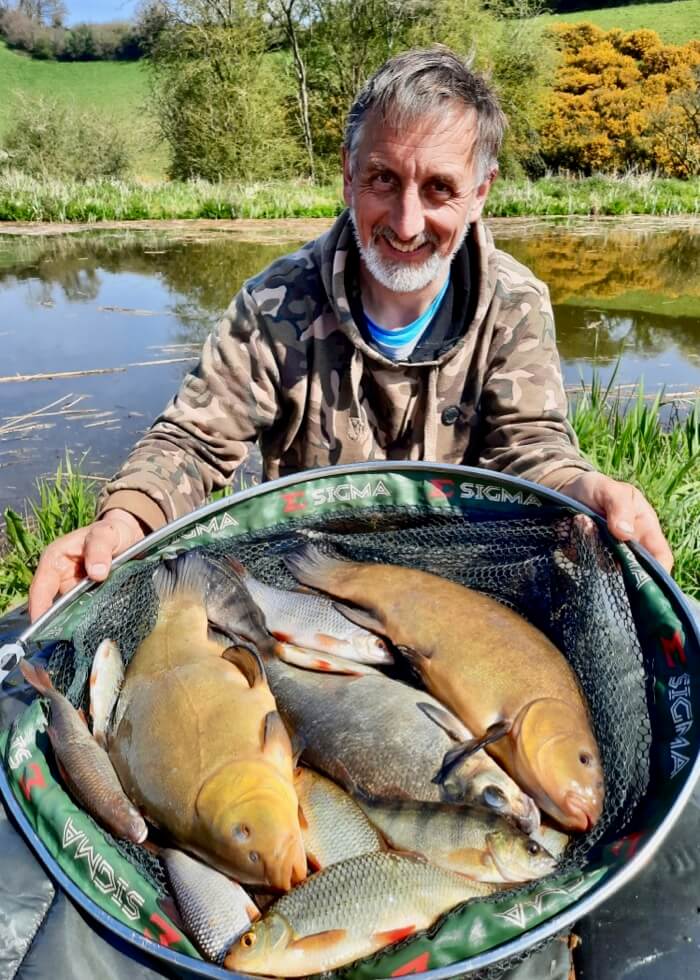
How’s that for a mixed spring bag??
In the end, Paul had another cracking tench, a big skimmer of about a pound and a half, and lost at least one other “net” fish. The bright weather had meant the going got tough later on- but what perfect light for a catch picture! I can’t remember the last picture I took that says “perfect spring fishing” so emphatically! And better still it was still not even noon, so we could now look for some sport on the fly rod.
Over to the stream
With a hot afternoon now in prospect, we had a choice: canal rudd or river trout on the fly? With the canal rather green and algae tinged still (it tends to be like this for a few weeks, before clearing up later in May and June), I fancied either option would work, but that the trout would be the best option.
And so we headed to a small River Exe tributary to try and winkle out some fish. There are several good semi-urban sections to try, provided you don’t mind a bit of accidental company (and one of the benefits of getting a day booked with me is that I can take you to various bits that you won’t find online or in the guidebooks).
Initial impressions were that the water was pretty low (it’s been a bone dry spring!) and that the trout looked very spooky in any smooth water. Hence my advice was to head straight for the broken bits, where stronger, twisting currents would mask our presence better.
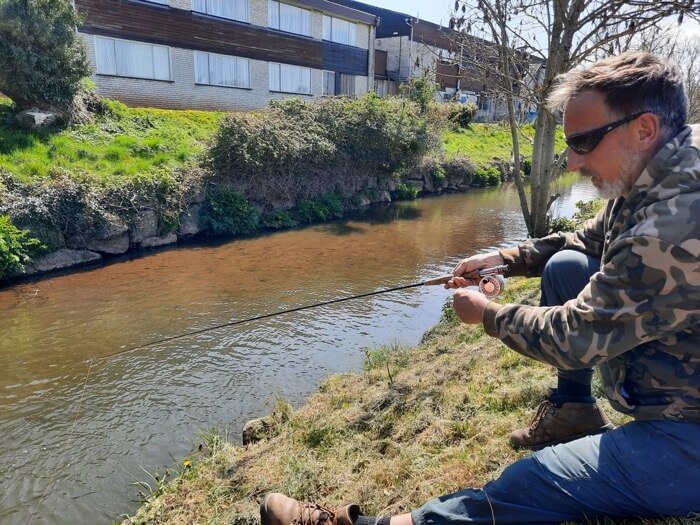
I needn’t have worried about the low water in the end- or Paul’s insistence that he wasn’t any kind of fly fishing genius! He put the fly in just the right places- and the pools paid off better than the smooth water, much as expected. We fished a very simple 9ft tapered leader of 3.5lbs, with a rig ring to 2ft of 3lb tippet. A tiny foam indicator suspended a small nymph such as a simple beaded Hare’s Ear or PTN, and that was all that was required- other than keeping a low profile and moving on whenever the fish spooked.

The time really whizzed by, Paul was having such fun. We got to the point when we were losing count of the number of takes and fish caught and quickly slipped back! Indeed, some anglers still get stuffy about the indicator and nymph method, but it’s deadly and incredibly practical- and so often on our tiny Devon rivers the modern French leader tactics just don’t really suit- even if you could get close enough to the fish, you’d be whacking trees with every other cast with a long rod (whereas a 7 or 8 ft 3 or 4 weight is perfect).
Eventually, we were running out of time, but seeing a few fish slashing at small sedges and olives, I couldn’t resist seeing if Paul could take a fish on the dry. I think even he was surprised by the kind of spots I recommended: rushing water, boulders and tiny “pockets” often no bigger than a table mat. I demonstrated how to just tickle a bushy dry fly in such gaps and without wanting to pinch the rod for long, a nice trout shot out and grabbed the dry. Game on!
Seconds later, Paul did exactly the same and the reaction was instant! It just takes a bit of getting your head around that fish do indeed live in fast and turbulent water- and that often you only need two or three seconds in the right spot to win a take. Talk about violent takes- his last fish of the day came head and shoulders through the surface and then leapt a foot in the air!

Exciting stuff- and in the space of a few hours, we’d not only sampled some excellent coarse fishing, but Paul had gone from a newcomer to river trout fishing to landing a dozen wild fish and his first ever on a dry fly.
As the A-Team might say, I love it when a plan comes together! I love it even more when it comes together for an angler who is modest about their abilities but really shows that with just a small push in the right direction they can get some brilliant results. The only trouble now is that if he’s pegged next to me in a match, he now knows a lot of my little tricks and tactics. Never mind- I will take it as a compliment if he beats me!
Should you want a guided day out with me this spring or summer, do get in touch. I can cover various bases, whether you want to learn to fly fish or enjoy a coarse fishing session with plenty of bites.
Match fishing at Summerhayes Fishery
Aside from the guided fishing, another enjoyable part of my fishing life has been getting back to competitive fishing with the Tiverton DAS league. It’s a great group of anglers that seems to find that perfect balance between competition and an out and out pleasure session with your mates.
It was a typical rural Somerset morning you might say- sparkling weather and a bit of roadkill en route. Well, rabbits are meant to be lucky, aren’t they?

Over a fried breakfast I also had a chortle at the venue gallery and a big carp accompanied by an even more impressive mullet. If Chris Waddle did mirror carp…
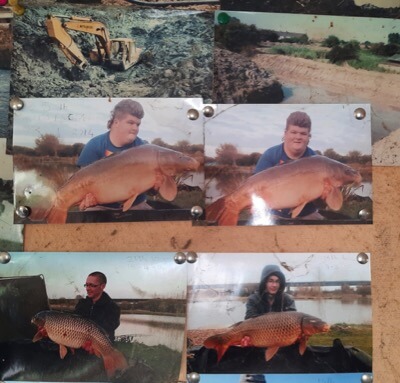
After a decent start at Little Yeo and nine league points in the bag, the pressure was on to keep it going. Summerhayes is a venue I quite like, too. Pole works a treat on many pegs, but my first line of attack tends to be a small method feeder. And with a decent draw on peg 10 I fancied a decent weight.
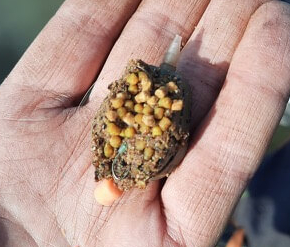
Why would you have any prayer against the pole doing this? Well, for one thing, line bites are less of a problem. You know that your hookbait is right among the feed- and every bite is a solidly hooked fish and not a foul hooker.
The match started slow, but I felt like I was holding my own with three decent fish for around ten pounds in the first 90 minutes. My neighbours were hooking a few- but line bites were an issue and a lot seemed to come adrift. Could I keep it going?
The honest answer was mixed, because things slowed down a lot and I probably chopped and changed too much. In hindsight, I should have sat on the tip for longer and given each cast more time. This is easier said than done in a match though- it’s hard to sit on your hands for long.
A switch to dead maggots brought some bites back, at least, and by fishing down the middle besides the far bank on the pole, I added another carp and three decent skimmers. Not plain sailing, but nobody within sight seemed to be cleaning up.
In the end it was a slog in the second half. I even tried using the pole shallow, with a piece of bread- but even that didn’t seem to be what the fish really wanted. I probably should have ditched that plan and stuck to the feeder, because while bites weren’t regular I would have ended up with more in the net. Another two carp seemed a bit mediocre for the peg I had, frankly. Nor did I feel like I fished the margins well enough, feeding too much bait and not giving this area enough time. Never mind- I had at least managed to break the 10kg mark and finished third in my half of the draw.

A tough day by Summerhayes standards, but eight more league points and a little bit of coin were very welcome. Hats off to Elliot Faye, who blitzed all of us with a softly-softly pole approach to win comprehensively with 36.9 kg of fish- over double that of second place!
Other angling reads this month…
Before I sign off, I should also give you a very quick heads up about some other articles and bits to enjoy. You can of course read my other exploits on the back page of the Angling Times each week- including some further thoughts on match fishing and an unusual carp bait to try this spring!
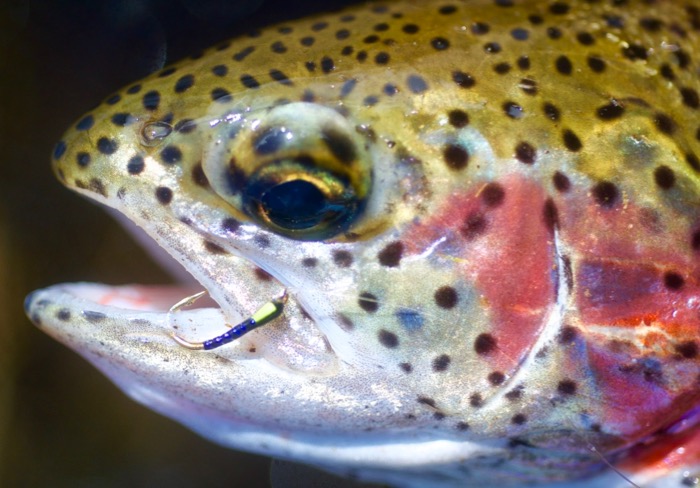
Meanwhile, I’ve also been doing some writing for FliesOnline, in particular an article on the excellent Burrator Reservoir (above). Having walked and fished on Dartmoor for so many years, goodness knows how it took me so long to wet a line here! Suffice to say the fishing and the company were excellent- and we definitely found the right flies and tactics on the day, after a bit of tinkering. Click here to read more.


